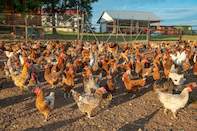Indigenous chickens are generally hardier and better adapted to South African climatic conditions than the commercial breeds, making them better suited for free-range and small-scale production. The more familiar indigenous chicken breeds in South Africa include the Boschveld chicken, Naked Necks, the Ovambo chicken, as well as Potchefstroom Koekoeks and Venda chicken.

Boschveld Chicken
The Boschveld chicken has not been approved as a registered breed in South Africa but has nevertheless become a preferred option for many subsistence and free-range farmers in various parts of Africa.
Farmer Mike Bosch developed the breed in 1998 on his farm in the Limpopo Province of South Africa, from a crossing of three indigenous breeds, namely, the Venda, Ovambo and Matebele. The breed is claimed to have captured the egg laying potential of the Venda, the size of the Matabele and the hardiness of the Ovambo.
The chicken has a light red-brown colour with white feathers in-between that helps to camouflage and protect them from predators. Roosters weigh about 1,6 kg at 12 weeks of age and 2,6 kg at 20 weeks, while the hens weigh 1,5 kg at 12 weeks and 1,7 kg at 20 weeks. The birds reach sexual maturity at 136 days of age. About 4 eggs are produced per hen per week.
Naked Neck Chickens
Naked Neck chickens have been classified as an indigenous breed that have evolved from Naked Neck chickens imported from Malaysia during the 17th Century. The birds have a variety of colour patterns.
According to Poultry Club SA, there are two types of Naked Necks, the one is purebred and has a completely naked neck, while there other is not purebred and has a tassel on the front part of the neck. They are classified as a heavy breed, with the roosters weighing roughly 1,5 kg when they are 16 weeks old, 1,95 kg at 20 weeks and 3,5 kg when fully grown.
The hens weigh around 1,1 kg when they are 16 weeks old, 1,4 kg at 20 weeks and 3 kg when they are fully grown. They reach sexual maturity at 155 days and produce eggs with an average weight of 55,5 grams.
The Naked Neck gene is used for commercial production in some countries, such as France. There are a few reasons for this. The birds, because they have about 30% fewer feathers than fully feathered birds, require less feed than other birds to reach the same weight and are also more heat tolerant. In addition, fewer feathers need to be removed during the slaughtering process.
Ovambo Chickens
Ovambo chickens originated in the Ovamboland of northern Namibia. This African chicken breed is characterised in layers, as they have a dark to black colour, with streaks of white and or orange.
Their light weight allows them to fly and roost in trees to avoid predators. According to Wicked Food Earth, the birds are highly aggressive and agile, known to catch and eat mice and young rats.
The roosters weigh about 1,74 kg at 16 weeks of age and 2,16 kg at 20 weeks. The hens weigh about 1,32 kg at 16 weeks and 1,54 kg at 20 weeks. Sexual maturity is reached when the birds are 143 days old.
Hens produce 129 eggs per year, with an average weight of 52,5 g per egg. The hens make good mothers and their broodiness helps to ensure their survival.
The Potchefstroom Koekoek
The Potchefstroom Koekoek was developed in the 1950s by Chris Marais from the Research Institute of Animal Husbandry and Dairying in Potchefstroom, out of crossings between Black Australorps, White Leghorns and Plymouth Rocks. The name “Koekoek” refers to the colour pattern of the breed.
The birds reach sexual maturity at 130 days. Hens lay brown shelled eggs with an average weight of 55,7 grams. They produce about 198 eggs per year. Roosters weigh about 1,84 kg at 16 weeks of age, 2,4 kg at 20 weeks and 3,5 kg to 4,5 kg when mature. Hens weigh about 1,4 kg at 16 weeks of age, 1,7 kg at 20 weeks and about 3,5 kg when fully mature.
The breed is popular among rural communities for both egg and meat production as well as their ability to hatch their own offspring. The colour of the birds is sex-linked, so if a black or red rooster is crossed with a Koekoek hen, the produced females will be completely black in colour, while the males will have a white spot on the head.
The Original Venda Chicken
The original Venda chicken was discovered by Dr Naas Coetzee, a Government Veterinary Surgeon of Bloemfontein, in 1979 in the Venda area of the Limpopo Province. The breed is multi-coloured, with white, black and brown being the predominant colours. It is a light breed with soft feathers.
The roosters weigh about 1,57 kg when they are 16 weeks old, 2,01 kg at 20 weeks and 2,9 kg to 3,6 kg when mature. The hens weigh about 1,24 kg at 16 weeks of age, 1,4 kg when they are 20 weeks old and 2,4 kg to 3 kg when mature.
The birds reach sexual maturity when they are about 143 days old. Hens produce large tinted eggs that weigh about 52,5 g. About 129 eggs are produced per year.
According to the Southern African Show Poultry Organisation Breed Standards description, Dr Coetzee was highly impressed by the breed’s "quality of egg production, self-sustainment, resistance against diseases, low need for food and broodiness".
Similar chicken were later also identified in the Southern Cape and Qua-Qua region of the Free State.
By Glenneis Kriel